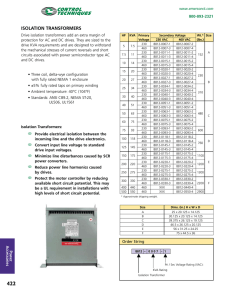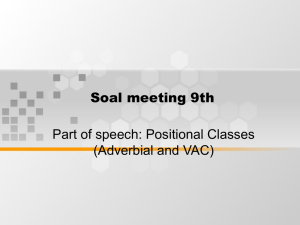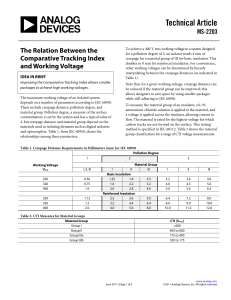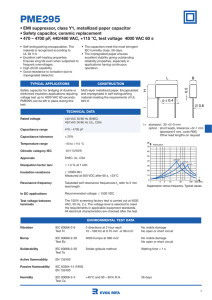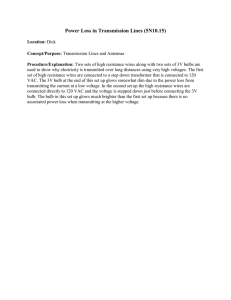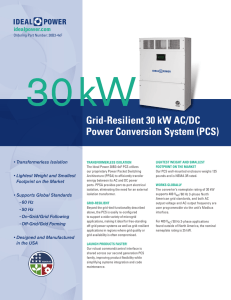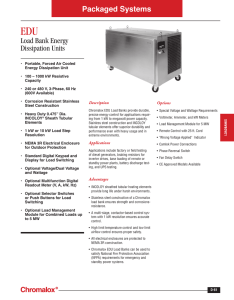Selecting Power Supplies for Medical Equipment Designs
advertisement
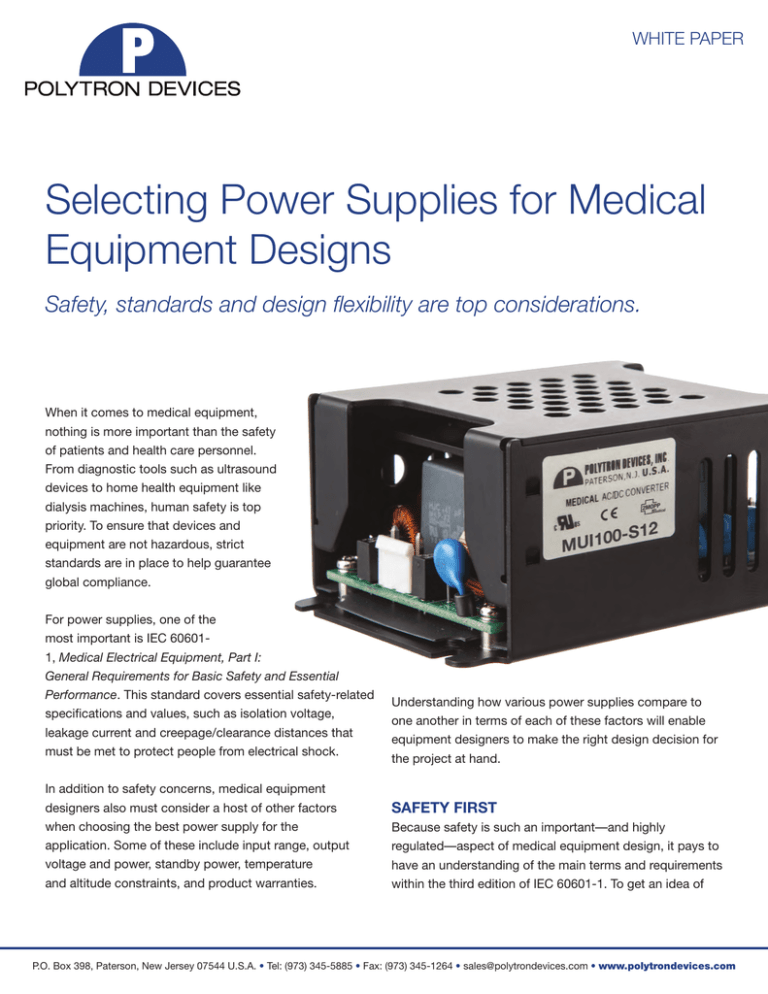
WHITE PAPER Selecting Power Supplies for Medical Equipment Designs Safety, standards and design flexibility are top considerations. When it comes to medical equipment, nothing is more important than the safety of patients and health care personnel. From diagnostic tools such as ultrasound devices to home health equipment like dialysis machines, human safety is top priority. To ensure that devices and equipment are not hazardous, strict standards are in place to help guarantee global compliance. For power supplies, one of the most important is IEC 606011, Medical Electrical Equipment, Part I: General Requirements for Basic Safety and Essential Performance. This standard covers essential safety-related specifications and values, such as isolation voltage, leakage current and creepage/clearance distances that must be met to protect people from electrical shock. In addition to safety concerns, medical equipment designers also must consider a host of other factors when choosing the best power supply for the application. Some of these include input range, output voltage and power, standby power, temperature and altitude constraints, and product warranties. Understanding how various power supplies compare to one another in terms of each of these factors will enable equipment designers to make the right design decision for the project at hand. SAFETY FIRST Because safety is such an important—and highly regulated—aspect of medical equipment design, it pays to have an understanding of the main terms and requirements within the third edition of IEC 60601-1. To get an idea of P.O. Box 398, Paterson, New Jersey 07544 U.S.A. • Tel: (973) 345-5885 • Fax: (973) 345-1264 • sales@polytrondevices.com • www.polytrondevices.com what the standard covers, one can simply review a list of typical tests for medical electrical systems. Some of these include testing for leakage current, grounding impedance, isolation voltage and electromagnetic compatibility. Compared to industrial power supplies, the levels required for medical power supplies are much stricter. As an example of what IEC 60601-1 codifies, isolation is required between the ac input, internal high-voltage stages and dc output in order to prevent electrical shock to the operator or patient. To ensure correct and sufficient isolation, either double insulation or reinforced insulation should be used in medical power supplies instead of a protective earth (Class II isolation). Class I electrical equipment only calls for basic insulation and uses a protective earth to avoid electrical shock, and is suitable for certain equipment. Other terms within IEC 60601-1 to be familiar with include the means of protection used, describing the isolation protection between the electrical circuits and equipment that may contact the device. Isolation protection includes creepage/clearance distances, insulation, and protective earths. Subcategories for this term include MOOP (means of operator protection) and MOPP (means of patient protection). The standard sets the following criteria for medical power supplies: For MOOP, one layer of insulation at 240 Vac requires test voltage of 1500 Vac and 2.5-mm creepage, while double insulation at 240 Vac requires test voltage of 3000 Vac and 5-mm creepage. For MOPP, one layer of insulation at 240 Vac requires test voltage of 1500 Vac and 4-mm creepage, while double insulation at 240 Vac requires test voltage of 4000 Vac and 8-mm creepage. Insulated Barrier Conductors Insulating Surface Air Gap Clearance Creepage Under the IEC 60601-1 safety standard, proper creepage and clearance distances help power supplies achieve sufficient isolation protection between the electrical circuits and equipment that may contact the device. P.O. Box 398, Paterson, New Jersey 07544 U.S.A. • Tel: (973) 345-5885 • Fax: (973) 345-1264 • sales@polytrondevices.com • www.polytrondevices.com Leakage current, or touch current, is another issue covered within IEC 60601-1. Touch currents are defined as the leakage paths from an enclosure that may contact a patient or operator. Because medical patients are often in a weak state, even a small amount of leakage current can have an adverse health effect. The standard specifies maximum levels of 100 µA for normal operation and 500 µA for a single fault condition. Closely related to the leakage current concept is the test that measures it: The total patient leakage current test measures the leakage current when all “applied parts” required to operate the medical device are in contact with the patient. Applied part means the part of the medical device that may contact the patient during normal operation and includes three classes: B (body/least stringent), BF (body floating/more stringent than B, less than CF), and CF (cardiac floating/most stringent/in direct contact with heart). For example, B-rated parts such as hospital beds require 4000 Vac input to output isolation, 1500 Vac input to ground isolation and 500 Vac output to ground isolation. In contrast, BF/CF-rated parts require 4000 Vac input to output isolation, 1500 Vac input to ground isolation and 1500 Vac output to ground isolation. An example of a Type BF part is a blood pressure monitor, whereas a CF example is a dialysis machine. Be sure that your medical power supply adheres to the values spelled out in IEC 60601-1. Not all power supplies meet these criteria. PERFORMANCE FACTORS AND DESIGN FLEXIBILITY Beyond strictly enforced safety standards, designers must also consider how different power supplies stack up when it comes to performance. For example, many DC-DC converters feature a 2:1 input voltage range and handle limited voltage, such as 4.5 to 36V. When possible, look for power supplies that offer additional design flexibility, such as a 4:1 input range and expanded voltage values of 4.5 to 75V. Having a wider input range translates to much greater flexibility for unforeseen design iterations requiring higher input voltages or the need to develop several versions of the same basic equipment model. Standby power is another consideration. As hospitals, health care facilities and patients themselves become more concerned about energy efficiency and conserving resources, the amount of standby power consumed by various devices becomes an important issue. Some medical power supplies use standby power as low as 0.15W, whereas similarly sized devices consume as much as 0.48W. Be sure to look at this specification when making applesto-apples comparisons of various power supply choices. Environmental factors are yet another area to take into consideration. For example, many DC-DC converters are limited to operating within ambient temperatures of -40º to 60ºC at full load operation. Yet others can handle -40º to 77ºC at full load, offering a substantial improvement in design flexibility. The same idea holds true for AC-DC converters: Some can P.O. Box 398, Paterson, New Jersey 07544 U.S.A. • Tel: (973) 345-5885 • Fax: (973) 345-1264 • sales@polytrondevices.com • www.polytrondevices.com handle ambient temperatures to 70ºC, while equivalent designs from other suppliers can withstand 80ºC. Read specifications carefully or ask your potential supplier about these engineering values in order to make the most informed decision. Beyond temperature constraints, be sure to consider operating altitude as well. While many DC-DC and AC-DC power supplies are designed for altitudes of 3000 m or less, others can function to 5000 m. This value can limit where the medical equipment can reliably operate. Finally, don’t forget to ask about product warranties. Many medical power supplies feature a standard three-year warranty, while some offer full fiveyear warranties. When deciding on a power supply, it is wise to understand warranty details before purchasing. Electromagnetic interference (EMI) is another challenge that must be considered. Because devices such as patient monitors operate with low-level signals within hospital settings, this type of equipment is more sensitive to EMI than typical industrial equipment. Due to this reality, electromagnetic compatibility is another area that is regulated by standards and tested for performance. Whenever possible, look for medical power supplies (both DC-DC and AC-DC converters) that feature built-in EMI filters. Finally, one more design consideration for AC-DC converters is packaging style. While most power converters come in open frame styles, others are also available in chassis mount, DIN rail mount and enclosed configurations. Depending on the medical equipment, power supply packaging may be a key factor in the overall design. In summary, selecting the right power supply for your next medical equipment design is a matter of knowing which engineering values to look at when making product comparisons. Top priorities include safety-related specifications and values, such as isolation voltage, leakage current and creepage/clearance distances that must be satisfied to protect people from electrical shock. Beyond safety, equipment designers also must consider factors such as input range, output voltage and power, standby power, operating temperature and altitude, and product warranties. Knowing how medical power supplies compare to one another in terms of these values will help equipment designers make appropriate design decisions. To learn more about Medical Power Supplies, please visit: www.polytrondevices.com/applications/medical P.O. Box 398, Paterson, New Jersey 07544 U.S.A. • Tel: (973) 345-5885 • Fax: (973) 345-1264 • sales@polytrondevices.com • www.polytrondevices.com
